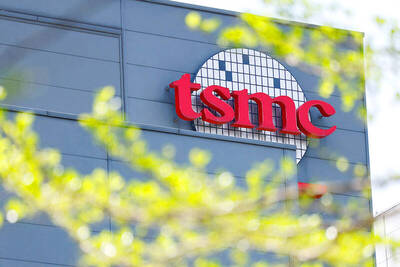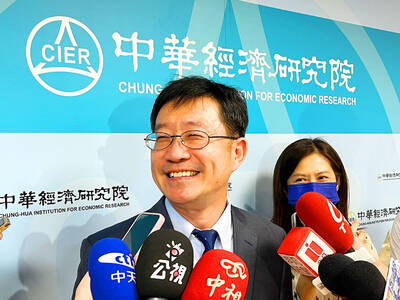Powerchip Semiconductor Manufacturing Corp (力積電) yesterday reported that its net losses last quarter shrank 79.2 percent from the previous quarter, reflecting improving gross margin as the company’s factory utilization increased and the cost of idle capacity was reduced.
Net losses in the January-to-March period totaled NT$439 million (US$13.56 million), compared with losses of NT$2.11 billion during the previous three months, the pure-play wafer foundry firm said in a document released after the company’s earnings conference.
Last quarter, Powerchip’s revenue fell 3.06 percent to NT$10.82 billion during the industry’s low season, compared with NT$11.16 billion the previous quarter, the company said.

Photo: Lam Yik Fei, Bloomberg
However, gross margin improved by 12.3 percentage points to 15.4 percent, while operating margin was minus-9.9 percent, better than the minus-18.1 percent recorded in the previous quarter, it said.
Last quarter’s net losses translated into losses per share of NT$0.11, compared with losses per share of NT$0.52 the previous quarter, company data showed. The result was roughly in line with market estimates of losses per share of NT$0.1.
However, Powerchip’s top-line and bottom-line results in the first quarter were still lower than the same period last year, with revenue down 5.49 percent and net profit plunging 335 percent due to softening end-market demand and its customers’ continued inventory adjustments, it said.
Powerchip, which makes DRAM and flash chips, as well as power management and driver ICs, on a contract basis, said the massive earthquake that hit Taiwan’s east coast on April 3 would affect its second-quarter shipments by 5 to 8 percent.
The quake measured 7.2 on the Richter scale and magnitude 7.4 on the moment magnitude scale.
The company said the recovery rate of its production lines reached 80 percent within three days of the earthquake and 95 percent within one week.
It hopes 50 to 60 percent of its quake losses — such as scrapped chips and damaged components — would be covered by insurance, Powerchip said.
For this quarter, average selling prices of memory products are expected to climb as end-market demand rises and customers face less inventory pressure, while prices of discrete components and power management ICs could remain stable, it said.
However, prices of CMOS image sensors and small-size display driver ICs, which accounted for about 20 percent of the company's revenue, would face competition from Chinese rivals, making it a key variable affecting the company's profitability, Powerchip said.
Overall, it is cautiously positive about its revenue performance this quarter and expects gross margin to be flat or higher than last quarter, driven by improving factory utilization for logic chip and memorychip operations, the company said.
Powerchip said it has raised its capital expenditure this year to NT$32 billion from an earlier budget of NT$24 billion, as it is adjusting its product mix to cope with market changes and customers’ needs as well as respond to inflation-driven equipment cost increases.

Six Taiwanese companies, including contract chipmaker Taiwan Semiconductor Manufacturing Co. (TSMC), made the 2025 Fortune Global 500 list of the world’s largest firms by revenue. In a report published by New York-based Fortune magazine on Tuesday, Hon Hai Precision Industry Co. (better known as Foxconn) ranked highest among Taiwanese firms, placing 28th with revenue of US$213.69 billion. Up 60 spots from last year, TSMC rose 60 places to reach No. 126 with US$90.16 billion in revenue, followed by Quanta Computer Inc. at 348th, Pegatron Corp. at 461st, CPC Corp., Taiwan at 494th and Wistron Corp. at 496th. According to Fortune, the world’s

NEW PRODUCTS: MediaTek plans to roll out new products this quarter, including a flagship mobile phone chip and a GB10 chip that it is codeveloping with Nvidia Corp MediaTek Inc (聯發科) yesterday projected that revenue this quarter would dip by 7 to 13 percent to between NT$130.1 billion and NT$140 billion (US$4.38 billion and US$4.71 billion), compared with NT$150.37 billion last quarter, which it attributed to subdued front-loading demand and unfavorable foreign exchange rates. The Hsinchu-based chip designer said that the forecast factored in the negative effects of an estimated 6 percent appreciation of the New Taiwan dollar against the greenback. “As some demand has been pulled into the first half of the year and resulted in a different quarterly pattern, we expect the third quarter revenue to decline sequentially,”

WEAKER ACTIVITY: The sharpest deterioration was seen in the electronics and optical components sector, with the production index falling 13.2 points to 44.5 Taiwan’s manufacturing sector last month contracted for a second consecutive month, with the purchasing managers’ index (PMI) slipping to 48, reflecting ongoing caution over trade uncertainties, the Chung-Hua Institution for Economic Research (CIER, 中華經濟研究院) said yesterday. The decline reflects growing caution among companies amid uncertainty surrounding US tariffs, semiconductor duties and automotive import levies, and it is also likely linked to fading front-loading activity, CIER president Lien Hsien-ming (連賢明) said. “Some clients have started shifting orders to Southeast Asian countries where tariff regimes are already clear,” Lien told a news conference. Firms across the supply chain are also lowering stock levels to mitigate

DIVERSIFYING: Taiwanese investors are reassessing their preference for US dollar assets and moving toward Europe amid a global shift away from the greenback Taiwanese investors are reassessing their long-held preference for US-dollar assets, shifting their bets to Europe in the latest move by global investors away from the greenback. Taiwanese funds holding European assets have seen an influx of investments recently, pushing their combined value to NT$13.7 billion (US$461 million) as of the end of last month, the highest since 2019, according to data compiled by Bloomberg. Over the first half of this year, Taiwanese investors have also poured NT$14.1 billion into Europe-focused funds based overseas, bringing total assets up to NT$134.8 billion, according to data from the Securities Investment Trust and Consulting Association (SITCA),